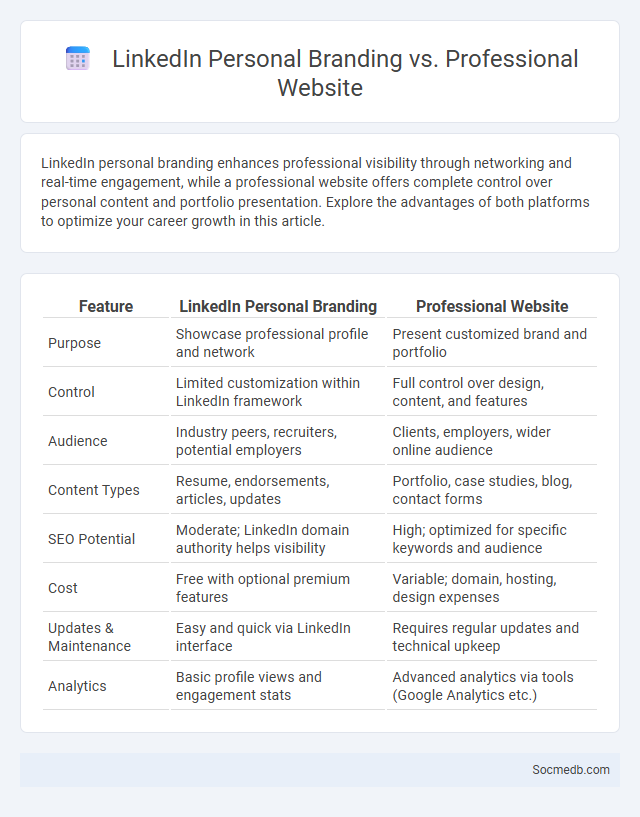
Photo illustration: LinkedIn Personal Branding vs Professional Website
LinkedIn personal branding enhances professional visibility through networking and real-time engagement, while a professional website offers complete control over personal content and portfolio presentation. Explore the advantages of both platforms to optimize your career growth in this article.
Table of Comparison
| Feature | LinkedIn Personal Branding | Professional Website |
|---|---|---|
| Purpose | Showcase professional profile and network | Present customized brand and portfolio |
| Control | Limited customization within LinkedIn framework | Full control over design, content, and features |
| Audience | Industry peers, recruiters, potential employers | Clients, employers, wider online audience |
| Content Types | Resume, endorsements, articles, updates | Portfolio, case studies, blog, contact forms |
| SEO Potential | Moderate; LinkedIn domain authority helps visibility | High; optimized for specific keywords and audience |
| Cost | Free with optional premium features | Variable; domain, hosting, design expenses |
| Updates & Maintenance | Easy and quick via LinkedIn interface | Requires regular updates and technical upkeep |
| Analytics | Basic profile views and engagement stats | Advanced analytics via tools (Google Analytics etc.) |
Understanding LinkedIn Personal Branding
Understanding LinkedIn personal branding enhances your professional visibility by showcasing your expertise, skills, and achievements to a targeted network of industry professionals. Optimizing your profile with relevant keywords and a compelling summary helps attract recruiters and potential clients, driving career opportunities. You can leverage LinkedIn's features such as endorsements, recommendations, and content sharing to build credibility and establish a strong online presence.
Defining a Professional Website for Personal Branding
A professional website for personal branding serves as your digital portfolio, showcasing your skills, accomplishments, and unique value proposition to potential clients or employers. It integrates clear navigation, high-quality content, and consistent branding elements to establish credibility and foster trust. Your website should also optimize social media links and contact information to drive engagement and career opportunities.
The Core Elements of Personal Branding
Your personal branding on social media hinges on authenticity, consistency, and clear messaging that reflects your unique value proposition. Crafting visually appealing profiles paired with engaging content strengthens your online presence and fosters trust among your audience. Effective use of social media analytics enables you to tailor your strategy, ensuring your brand resonates deeply with your target community.
Key Differences: LinkedIn vs Professional Website
LinkedIn serves as a dynamic social networking platform tailored for professional connections, job searching, and industry news sharing, while a professional website functions as a personalized digital portfolio showcasing an individual's skills, projects, and brand identity. LinkedIn offers built-in networking tools and organizational endorsements, whereas a professional website provides full customization, control over content, and SEO optimization to attract targeted audiences. Both complement each other by combining broad visibility on LinkedIn with the depth and professionalism of a dedicated online presence.
Audience Reach: LinkedIn vs Personal Website
LinkedIn offers extensive audience reach through its professional network of over 900 million users, enabling targeted engagement with industry-specific groups and potential clients. In contrast, a personal website provides controlled and customizable content, attracting visitors through search engine optimization (SEO) and organic traffic driven by unique, value-packed content. Leveraging both platforms enhances visibility by combining LinkedIn's social proof and networking capabilities with a personal website's authority and tailored user experience.
Content Control: Limitations and Freedom
Social media platforms balance content control by enforcing community guidelines that restrict harmful or offensive material while allowing users the freedom to express diverse opinions. Algorithms and moderation tools filter content to prevent misinformation and hate speech, yet debates persist over censorship and the impact on free speech. Users navigate evolving policies that aim to create safe environments without stifling creativity or discourse.
SEO Impact and Online Visibility
Social media platforms enhance SEO impact by driving targeted traffic to websites, increasing brand mentions, and generating high-quality backlinks, which improve search engine rankings. Consistent engagement and optimized content on channels like Facebook, Instagram, and LinkedIn amplify online visibility, making businesses more discoverable in search results. Leveraging social media analytics aids in refining keyword strategies and content relevance, further boosting organic reach and domain authority.
Building Credibility and Trust
Establishing credibility and trust on social media hinges on consistently sharing authentic content and engaging transparently with followers. Brands that respond promptly to comments and address concerns demonstrate reliability, which fosters loyal communities. Showcasing verified testimonials and industry expertise further strengthens trust and enhances reputation.
Integration Strategies: Combining Both Platforms
Effective integration strategies for social media involve combining platforms like Facebook and Instagram to maximize reach and engagement. You can synchronize content schedules and use cross-platform advertising tools to create a cohesive brand presence. Leveraging analytics from both platforms allows for optimized targeting and improved campaign performance.
Choosing the Right Platform for Your Personal Brand
Selecting the right social media platform for your personal brand depends on your target audience, content style, and engagement goals. Platforms like Instagram excel for visual storytelling, LinkedIn suits professional networking, while TikTok targets younger, trend-driven users. Tailoring your content to the unique features and demographics of each platform maximizes your brand's reach and impact.
 socmedb.com
socmedb.com